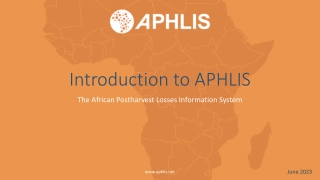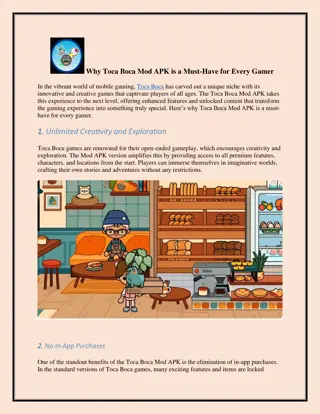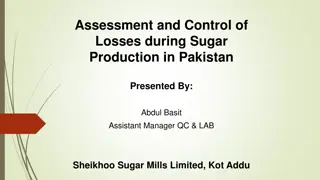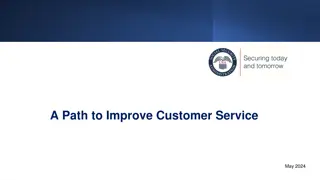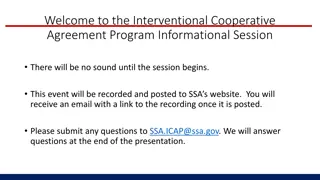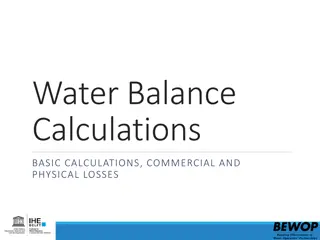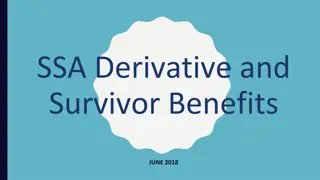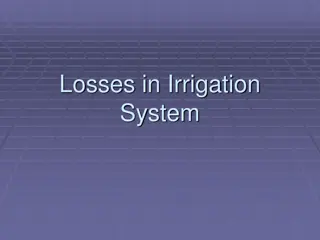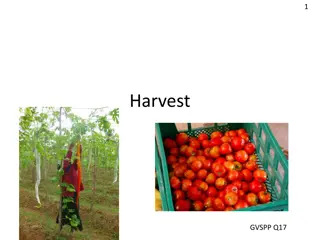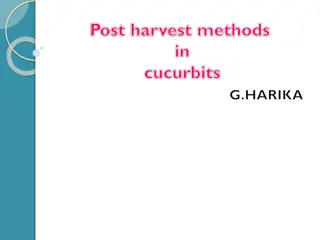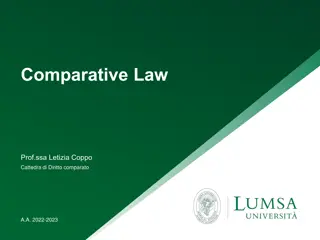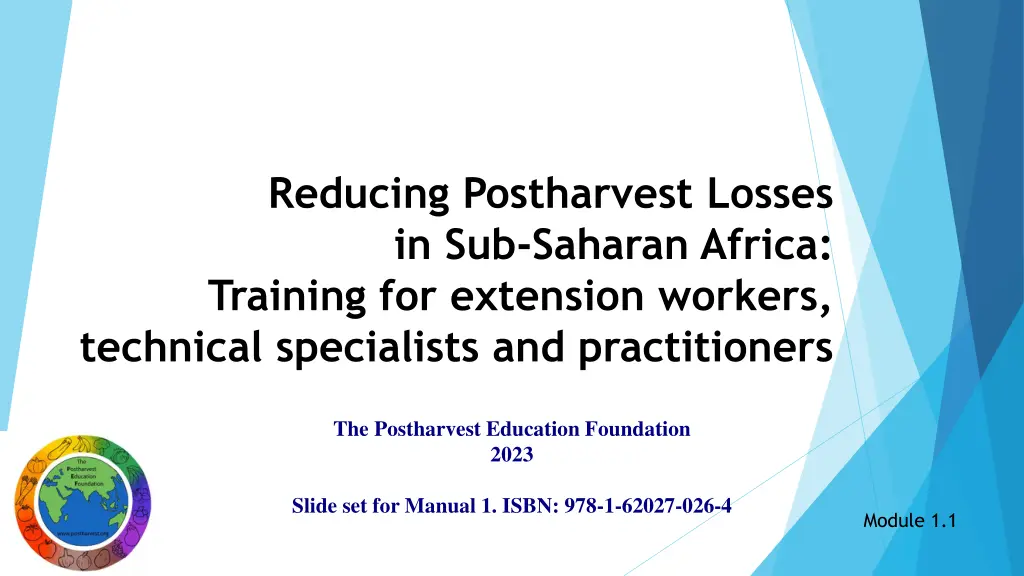
Reducing Postharvest Losses in Sub-Saharan Africa: Practical Solutions
Discover valuable insights into reducing postharvest losses in Sub-Saharan Africa, focusing on key foods, factors, and practices. Learn about proper maturity at harvest, gentle handling techniques, postharvest pest management, and more to enhance food sustainability and accessibility in the region.
Download Presentation

Please find below an Image/Link to download the presentation.
The content on the website is provided AS IS for your information and personal use only. It may not be sold, licensed, or shared on other websites without obtaining consent from the author. If you encounter any issues during the download, it is possible that the publisher has removed the file from their server.
You are allowed to download the files provided on this website for personal or commercial use, subject to the condition that they are used lawfully. All files are the property of their respective owners.
The content on the website is provided AS IS for your information and personal use only. It may not be sold, licensed, or shared on other websites without obtaining consent from the author.
E N D
Presentation Transcript
Reducing Postharvest Losses in Sub-Saharan Africa: Training for extension workers, technical specialists and practitioners The Postharvest Education Foundation 2023 Slide set for Manual 1. ISBN: 978-1-62027-026-4 Module 1.1
Module 1.1.9Overview: Sub-Saharan Africa - Reducing Postharvest Losses Learning objectives for practitioners To be aware of topics or areas of training/extension and advocacy that are needed to solve postharvest problems for a variety of crops/food products in the 3 food groups To gain an understanding of the many options available for addressing the causes of postharvest losses identified in food loss assessments. Mod. 1.1 Slide 1
Key foods that are important for the region Mod. 1.1 Slide 2
Summary of key factors for reducing postharvest losses Mod. 1.1 Slide 3
General overview of postharvest loss reduction practices Proper maturity at harvest More gentle handling of perishable crops to reduce damage Proper drying of cereals and pulses before storage Postharvest pest management Improved containers or packaging Temperature management/cooling and cold storage for perishable foods Improved storage for cereals and pulses Market access Supply chain efficiency as a goal Mod. 1.1 Slide 4
Proper maturity at harvest Harvesting too early: If fruits are harvested too early they will lack flavor, and may not be able to ripen. Harvesting too late: If root crops are left in the field too long, they can become fibrous or pithy (with poor eating quality) If cereals are left on the plant too long after full maturity, some of the grains can drop off and be lost during the harvest (shatter). Mod. 1.1 Slide 5
More gentle handling of perishables to reduce damage Rough handling occurs during all segments of the food supply chain: Digging damage to R&T crops Harvest wounds for F&V crops Bruises from dropping, throwing, tall heaps Compression damage from use of poor quality containers Stepping on produce during loading/unloading Mod. 1.1 Slide 6
Proper drying of cereals and pulses before storage Cereals and pulses that are put into storage at higher than recommended moisture content will be more susceptible to fungal attack and mold damage. Mod. 1.1 Slide 7
Postharvest pest management Postharvest pest management includes: Insect control Decay control Rodent control Rat guards fashioned from metal sheeting or empty cans. Source: FAO. 1985. Mod. 1.1 Slide 8
Improved containers or packaging Protecting food crops from damage is one of the key purposes of a package or container. Handling foods in poor quality packages and containers such as bundles, sacks or baskets leads to damage, spillage and deterioration. Green beans shipped in baskets from Benin to Ghana (Photo credit: Lisa Kitinoja); Leafy greens in sacks in Rwanda (Photo credit: S K Roy). Mod. 1.1 Slide 9
Temperature management for cereals and pulses The postharvest storage potential for harvested grains and pulses (cowpeas, dry beans, lentils) is longer when the crops are stored at lower temperatures. The allowable storage time (AST) for grains is reduced by approximately one-half for each 6 C increase in grain temperature. Mod. 1.1 Slide 10
Cooling and cold storage for perishable foods Temperature control has been found to be the most important factor in maintaining fresh produce quality. Fruits and vegetables are living, breathing tissues separated from their parent plant. Keeping F&V crops at their lowest safe temperature (0-2 C for temperate crops or 12-15 C for chilling sensitive crops) will increase storage life by lowering respiration rate, decreasing sensitivity to ethylene gas and reducing water loss. Cold rooms should not be overloaded, and incompatible crops should not be stored together. Mixed loads in cold storage in Cape Verde (Photo credit: Lisa Kitinoja) Mod. 1.1 Slide 11
Improved storage for cereals and pulses Investments in improved structures and storage management practices will keep the crops clean, dry and protected from pests. Mod. 1.1 Slide 12
Market access and supply chain efficiency Reducing marketing delays for perishable crops and improving market information systems for all food crops can help to reduce postharvest losses. Small-holder farmers are often dependent upon traders to visit the farm and pick up harvested produce to transport it to market. If the produce is perishable, a delay can result in lower quality and a long delay can result in a complete loss. For crops that can be stored for long periods of time, knowing the cost of storage, the cost of transport and the market prices in a range of local and regional markets can help farmers, traders and wholesalers determine when and where to sell the crops. Mod. 1.1 Slide 13
End of Module 1.1 (Overview) The next three Modules in Manual 1 provide details and examples of improved postharvest handling practices and cost-effective postharvest technologies for reducing losses in cereals & pulses, roots and tuber crops, and fruits and vegetables. Practitioners will learn how to select from the range of potential options for reducing food losses and consider each of the following: technical fit (scale of the technology, suitability for the crop) costs and expected benefits potential environmental impacts (energy use, pollution, etc.) related social issues (gender issues/roles, ethnicity, youth access, etc.) policy framework (does it fit into the existing system?, does the intervention have any support?) food safety issues. Mod. 1.1 Slide 14

